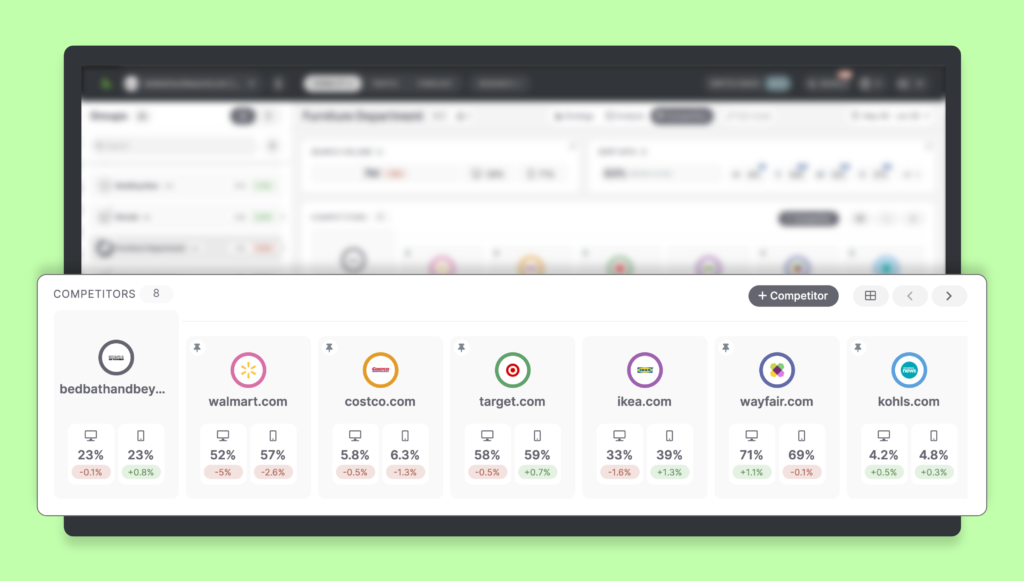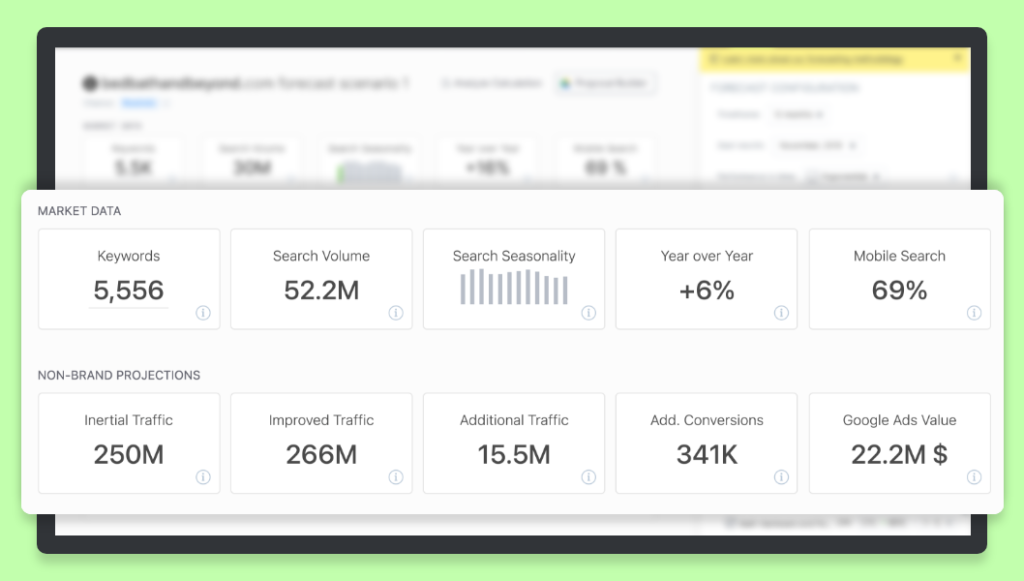30-second summary:
- Your SEO proposal plays an instrumental role not just for your agency but also for your client’s business
- Forecasting needs to be a star element of your customer acquisition process – but how do you navigate these tricky waters?
- SEOmonitor dissects the entire thought process and action plan for you
- Here’s how to ensure realistic, practical, achievable, and mutually agreed milestones and budgets are set with your clients
Clients often ask for a forecast to estimate their ROI with this type of marketing investment. Agencies are caught between building a realistic business case and explaining that they’re all scenarios, not promises. Think about it like this – you both need to know where you’re going, or you won’t have a clue when you’re there. But it’s all about how you set expectations from the start. This is where your SEO proposal plays an instrumental role in customer acquisition and experience.
Let’s imagine the following scenario: a Client Service Director argues about the benefits of presenting a business case to a new lead to make the sell.
Yet, the agency’s CEO wants to make sure the initial internal evaluation is on point. After all, it makes sense to calibrate your model first and then show the opportunity.
With the right forecasting methodology in place, you can do both and prove your SEO services’ business value.
The big question is how to go about it.
Content created in partnership with SEOmonitor.
What does SEO success mean for your client’s business?
To invest in SEO, a client needs to understand how that strategy translates into sessions, conversions, and ultimately revenue. So, as an agency, you need to connect the business metrics with the non-brand organic traffic and keyword ranks – the data that you directly impact.
Keywords are influenced by many variables that you need to consider when designing a trustworthy methodology to create realistic SEO scenarios.
And even before that, the way you do your keyword research influences those scenarios:
- What is the client’s industry trend like?
- What is their business trend? Are they in a growth phase, or are they plateauing?
- What is their market share in terms of organic real-estate (their visibility compared to their competitors)?
Understanding the opportunity for growth
The competitors’ keywords gap analysis
It’s common sense, but it can sometimes escape the client’s focus – showing them who their real online competitors are in terms of queries and search intent.
A perfume shop, for example, will be in tight competition with big retailers such as Amazon more than competing perfume shops, deciding to offer online services.
Exploring the client’s domain in connection with the competitor landscape will give you an overview of the overlapping and non-overlapping keywords, together with their key attributes (search volumes, seasonality, etc.). This is one significant way to understand which keywords are worth introducing into your SEO proposal and ulterior strategy so as not to get sidetracked by misleading keywords.
Continuing our perfume shop example, although the client might want to focus on a specific set of keywords, you’ll be able to make a compelling, data-based argument on why it’s important to improve non-overlapping keywords.
Let’s say you found out that a competitor to our perfume shop had dedicated pages for aroma-based perfumes, with listings that target “vetiver” or “white musk”. Replicating this won’t involve changing the client’s product line and will add new valuable keywords to the mix.
The client’s market share
Another way to evaluate the client’s business status quo is by using the Visibility metric as a market share indicator. Calculated as an impression share and weighted against search volumes, it shows you the growth potential compared to the client’s competitors and the total shares.
As it’s expressed as a percentage, you’ll know where to focus your attention.
For instance, if it’s a competitive market, and the main competitor has a Visibility of 70 percent, then improving the rankings for high-volume keywords in the top-three group will be a game-changer. You’ll also know which keywords to select for a winning SEO strategy.
Transparent calculations for a realistic timeframe
After thoroughly researching and selecting the targeted keywords at hand, modeling how the non-brand organic traffic might look if a particular performance is achieved in a timeframe of six or 12 months will help your agency set the right expectations.
To do so, you need to look at all the variables impacting your keyword list:
- Search seasonality and the keywords’ year-over-year trend
- How the inertial traffic influenced by seasonality only looks (as if the website’s rankings would stand still)
- The performance in time toward the SEO goal, calculated as linear or exponential
- The average CTR curve calculated for the top 10 positions for each mix of SERP features and device segmentation, showing you the actual clicks that manage to reach your client
- The long-tail keywords and their impact on forecasted traffic
With this model in mind, you get to estimate sessions and conversions instead of ranks. For instance, in SEOmonitor’s forecasting module, the estimation of the additional conversions is based on the estimated additional visits multiplied by the corresponding conversion rate of each keyword included in the calculation. You can verify each input and output at an individual keyword level and see what makes a realistic or too far-fetched scenario.
Thus, you transform the loaded notion of forecasting into a more tangible idea – various additional traffic scenarios which translate into possible business results, moving the conversation towards marketing added value.
To make a case for a certain scenario, you can highlight what their traffic would look like with and without the proposed SEO campaign, being transparent about what went into your calculations and what assumptions you’ve made.
Letting the client understand the overall opportunity and what’s in it for their business will help you set a common ground for success.
Is it the right budget for the client’s business now?
When your agency builds a business case, another important thing is to evaluate the direct connection between SEO performance and results, correlated to an objective benchmark that both, you and the client can easily gauge.
Compare the SEO budget and forecasted results to its equivalent in Google Ads, and you’ll have an external comparison showing the worth that SEO brings. For instance, if the estimated Google Ads Value for your realistic scenario is $55,000 for 12 months, then a $500 to $700 retainer seems more plausible than a $1,500 one.
In contrast, if the estimated Google Ads Value reaches $250,000+ for the same 12 months timeframe, it’s clear that we’re talking about international SEO on a highly competitive market and a $5,000 to $7,000 retainer at least.
Instead of guesstimations and the painful back and forth of establishing a budget benchmark, you’ll now have an overview of where the business is and how you can contribute in terms of revenue. So these calculations can help you set the right price for that client profile.
Even if you choose not to put that forecasting scenario in your proposal and instead negotiate KPIs after the SEO technical improvements are in place (the third or fourth month of collaboration), you’ll have an important internal calibration tool at your disposal.
The forecasting exercise helps assess if the new client’s objective is worth it and keeps your agency accountable for the SEO strategy you propose.
Is the campaign going in the right direction?
An initial business case with variable scenarios helps the agency define success for the new client. Then, it’s just as important to track the SEO campaign’s progress once it’s in place. After all, forecasting is just a way to estimate a possible future and set “a north star” for both of you. The rest depends on how the strategy evolves against the shifting context.
Here’s where re-forecasting plays a significant part.
Perhaps the agency decides to share KPIs for the first time in the third or fourth month of collaboration after implementing the audit requirements. Or it’s time for the quarterly review, and the initial SEO strategy and subsequent forecasting are scrutinized. Either way, it’s crucial to revise and adapt.
Maybe there are new keyword lists to add and model into a traffic scenario or a digital PR opportunity to add to the overall plan. Maybe the client has additional products or services that they want to optimize that weren’t included in the starting plan.
For instance, coming back to our perfume shop and its pandemic challenges, it’s important to touch base regularly to see what new opportunities are in store. They might be looking to branch out in the home fragrance industry but don’t know how much demand is in their target market. As their SEO agency, you can re-pitch an SEO campaign based on search data for “home perfumes” and design a creative digital PR campaign with that hook.
This step of the client relationship-building process is an added advantage in proving how you’ve created business value and what more you can do.
Summary
Effectively communicating your proposed SEO campaign’s value is crucial for potential clients to decide if –
- the price is right,
- the timeframe is right,
- the ROI is worth it.
It’s also a way to keep your agency honest and accountable.
A trustworthy forecasting methodology helps with all of the above, as you get to:
- Establish a common definition of what success looks like – rankings achieved for relevant keywords, Visibility achieved against competitors, and other established factors which directly translates to additional traffic, conversions, revenue
- Establish a realistic budget based on the client profile and its Google Ads equivalent value
- Keep track of the SEO objective and re-forecast when it’s the case to adjust the strategy
SEOmonitor’s forecasting module supports SEO agencies to do all that with reliable data and all the necessary variables, taking into account seasonality, YoY trends, and more.
Plus, with the Google Slides integration, you get a Proposal Builder that automatically pulls the forecast data and transforms your business scenario into a pitch-ready presentation.
The forecasting module is just one of the solutions SEOmonitor develops for agencies to acquire, manage, and retain more relevant customers.
Join us in our quest to bring more transparency to the SEO industry!
The post How to show the business value of your SEO proposal appeared first on Search Engine Watch.
This marketing news is not the copyright of Scott.Services – please click here to see the original source of this article. Author: SEOmonitor
For more SEO, PPC, internet marketing news please check out https://news.scott.services
Why not check out our SEO, PPC marketing services at https://www.scott.services
We’re also on:
https://www.facebook.com/scottdotservices/
https://twitter.com/scottdsmith
https://plus.google.com/112865305341039147737
The post How to show the business value of your SEO proposal appeared first on Scott.Services Online Marketing News.
source https://news.scott.services/how-to-show-the-business-value-of-your-seo-proposal/






No comments:
Post a Comment